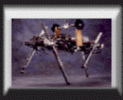
The 3D One-Leg Hopper was built for experiments on active balance and dynamics in legged locomotion. The machine has a leg that changes length, a body that carries sensors and interface electronics, and an actuated 2-axis hip. The hip is powered by hydraulics and the leg by compressed air. The machine has an overall height of 43.5 inches (l.l0 m) and a mass of 38 lbs. (l7.3 kg).
There were four reasons to build a 3D machine with only one leg. First, it is simpler to study balance a machine with one leg, because it eliminates the difficult task of coupling the behavior of several legs. Second, it forces one to focus on balance, because a one legged system has no other way to stand up. Third, the behavior and control of a one-legged device could be used as the corner-stone for each leg of multi-legged systems. Fourth, a one legged system has the minimum equipment. Less equipment means less construction time, less down time due to mechanical failure, and more reliable operation.
Experiments with the 3D One-Leg Hopper showed that balance can be achieved with a simple control system. The control system has three separate parts: one controlling forward running speed, one controlling body attitude, and one controlling hopping height. The 3D One-Leg Hopper hopped in place, travelled at a specified rate, followed simple paths, and maintained balance when disturbed. Top recorded running speed was 2.2 m/sec (4.8 mph). The 3D control algorithms were generalizations of those used earlier in 2D, with little additional complication.
